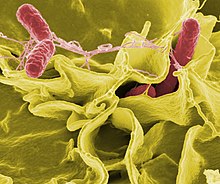 |
| An image of salmonella, courtesy of the Wikimedia Foundation. |
Recently,
a new method of salmonella identification has been discovered which will reduce
the process’s length by more than half. The standard practice, gel
electrophoresis, takes several days. The new technique devised by researchers
at Penn state will reduce the time to just one. This method focuses on just two
genes and two other small areas of the genome, which allow for accuracy similar
to that of standard electrophoresis. Considering that salmonella outbreaks need
to be traced to their source as fast as possible, this breakthrough is potentially
revolutionary, in terms of finding salmonella outbreaks. While salmonella only
seems to kill a few hundred people a year at most, this is only because we’ve
become very adept at finding and squashing the bad strains. As we become even
more effective, it will only become easier to destroy them. It’s not the most
extreme discovery, but it’s still a worthwhile one.
NOS Themes:
3.) The researchers only decided that the method worked after testing it in a blind study. It will very likely have to be tested much more thoroughly before being adopted by any other institutions.
4.) This method was devised in Penn State, a relatively well-known college, by an associate professor. While this doesn't bar the individual from needing to have their work reviewed, this person is probably not making things up, as he's managed to hold his position at the university for quite awhile.
This is really cool. Salmonella sickens about 40,000+ people per year, so hopefully this new method of identifying the bacteria will help to reduce that number by a lot.
ReplyDeleteHere's an article about the infection that salmonella causes.
http://www.cdc.gov/nczved/divisions/dfbmd/diseases/salmonellosis/
http://www.biosciencetechnology.com/news/2013/05/method-can-cut-salmonella-detection-time-half#.UavW6OCe1eQ
ReplyDeleteI read this other article about the same study. It was saying that the state health department supplied Penn State with Salmonella to subtype and they were very effective and efficient. 10 of the 20 samples were from a recent outbreak in Pennsylvania and 10 were not. They were able to identify which were from the outbreak.